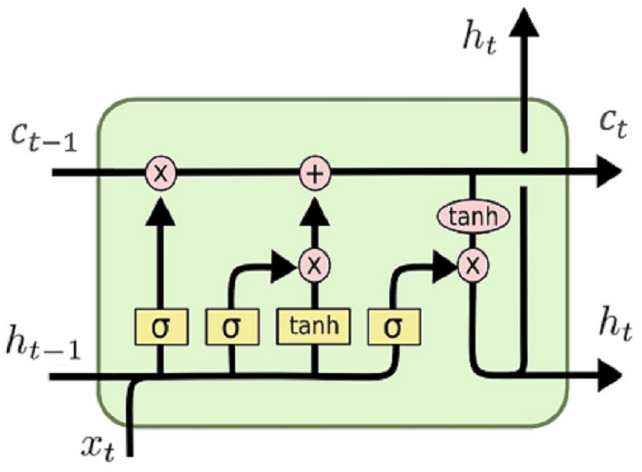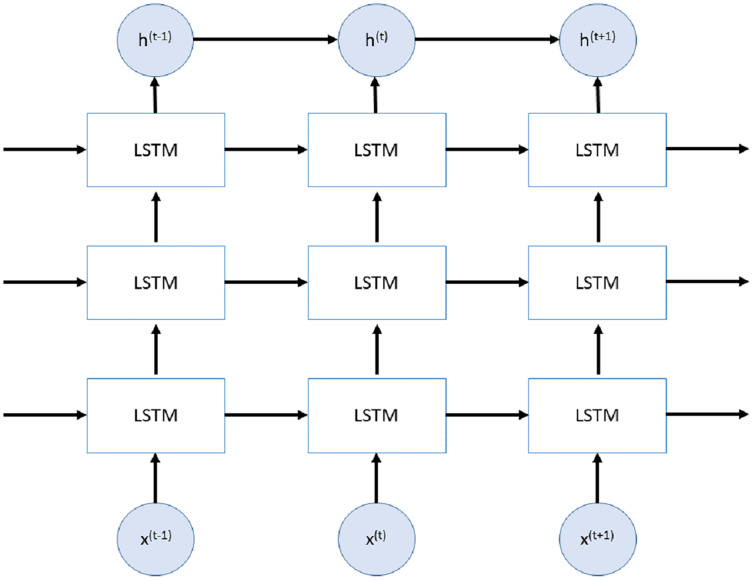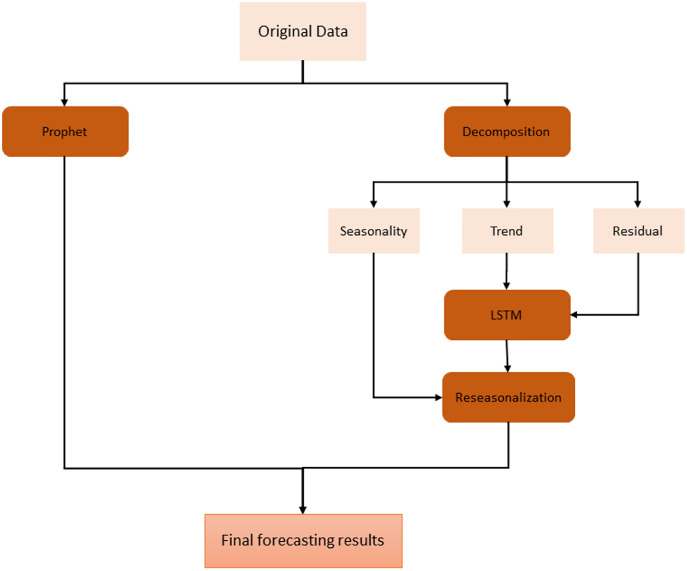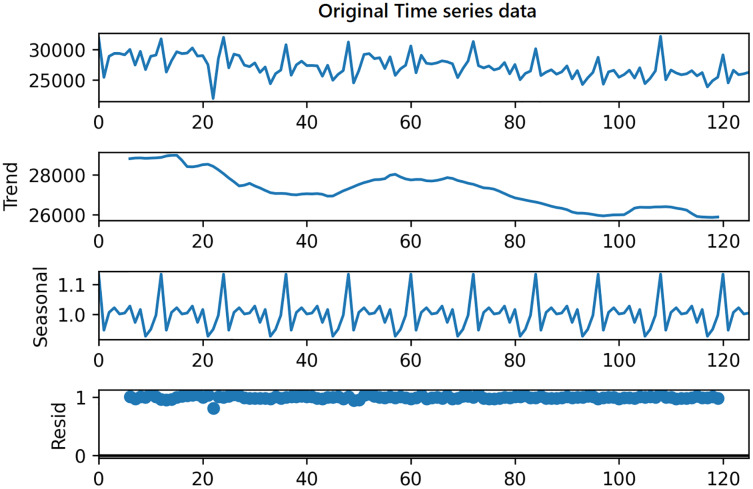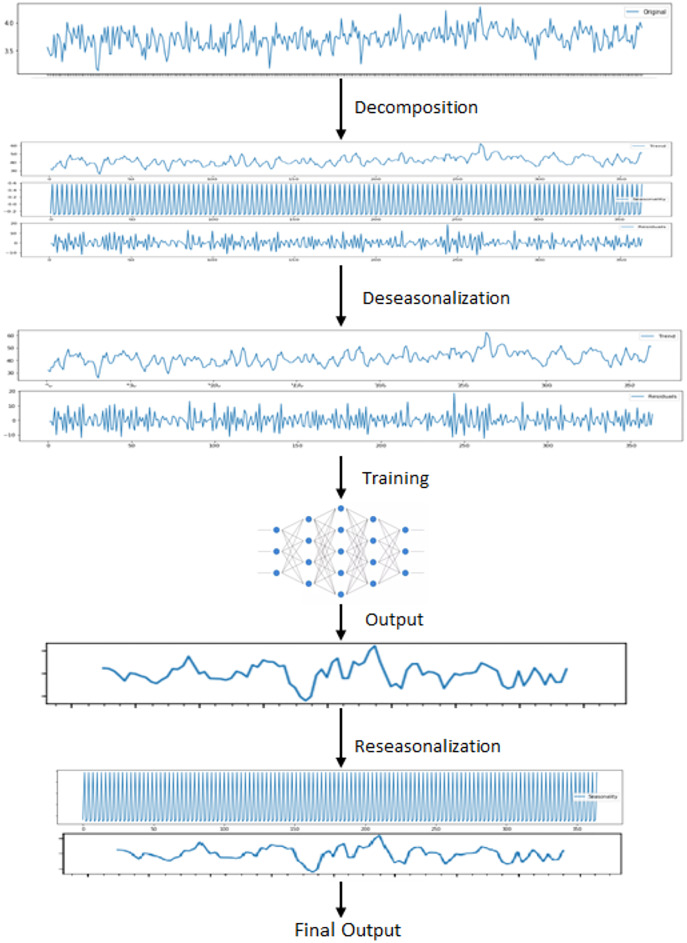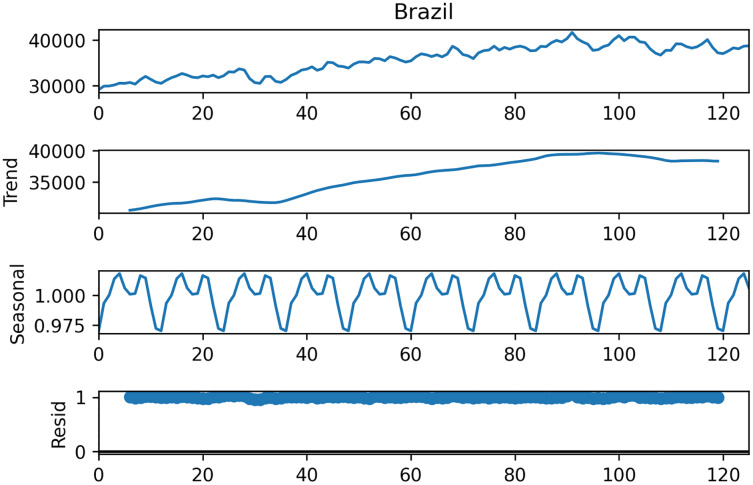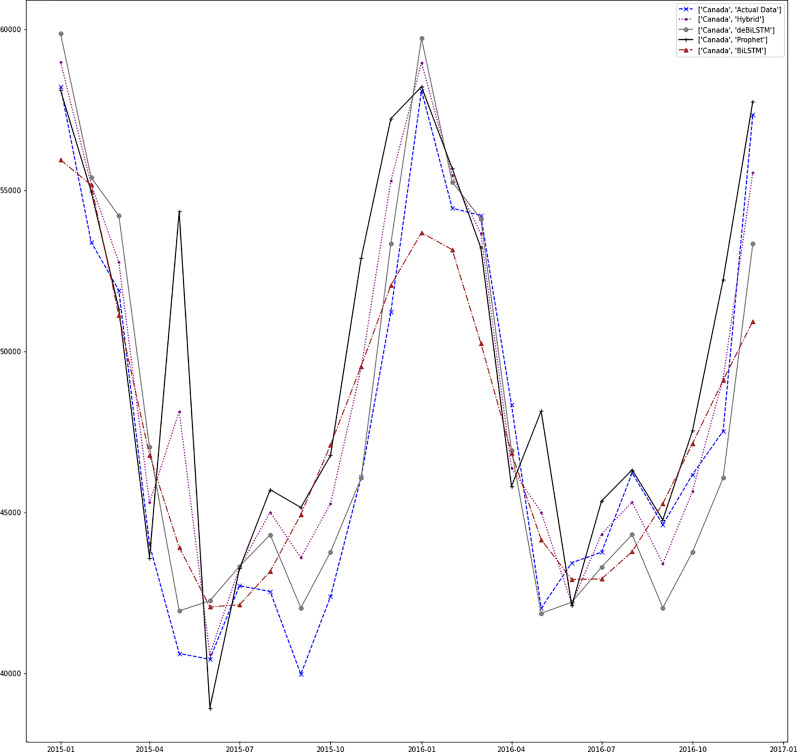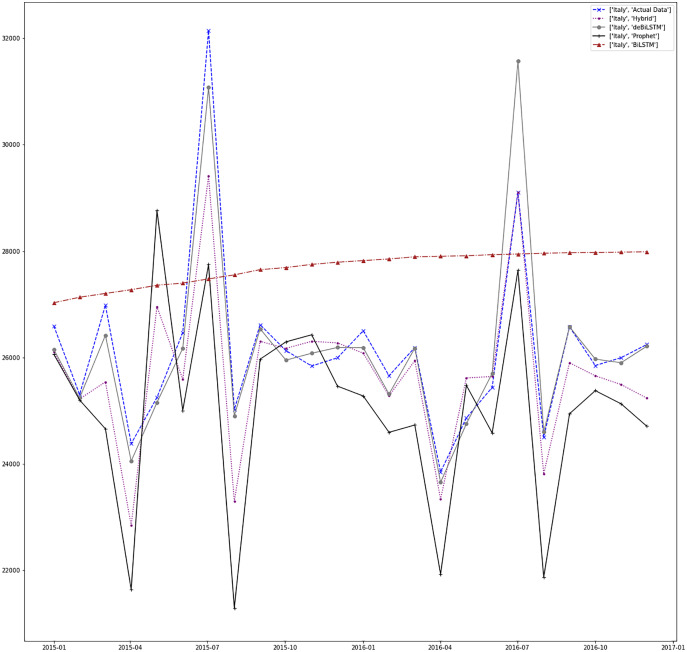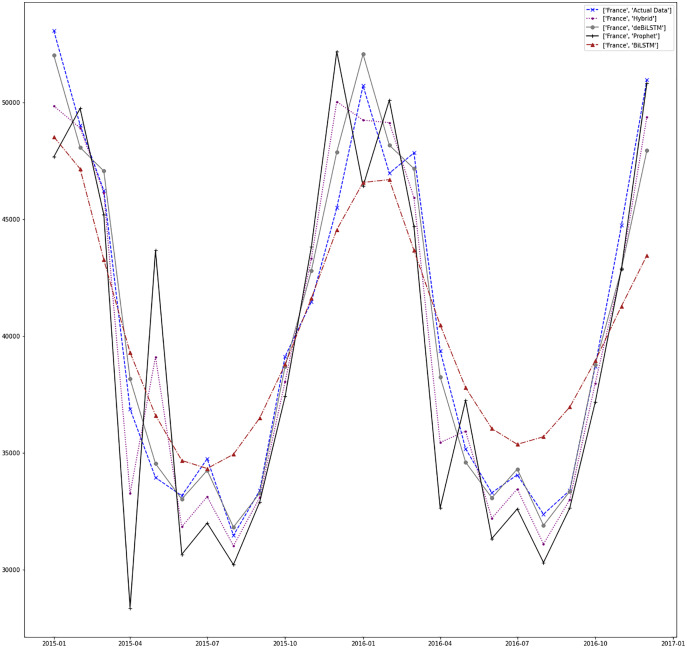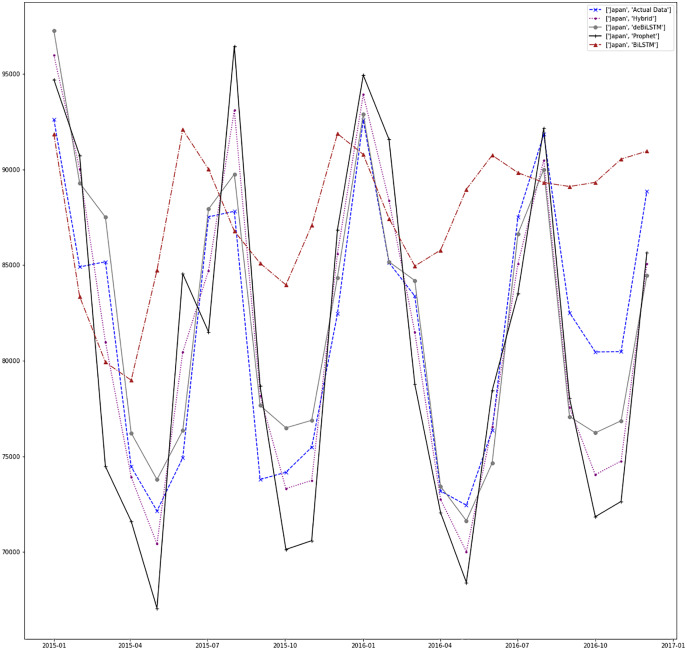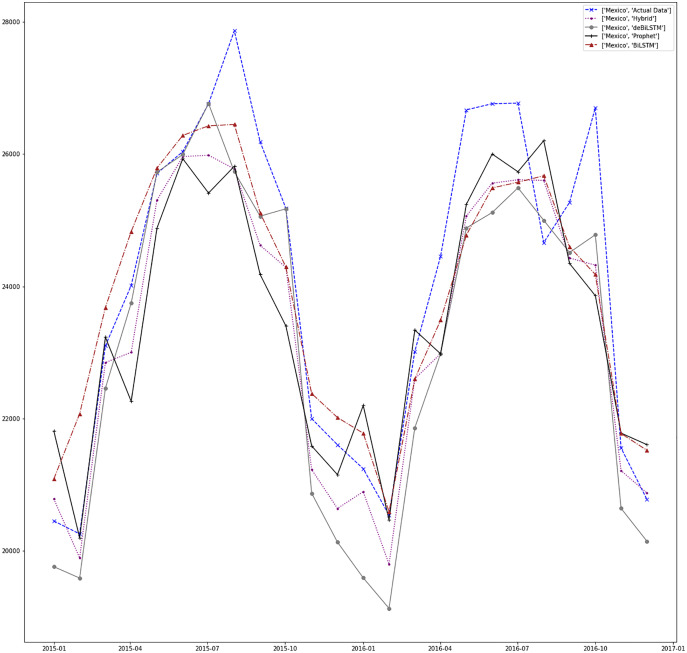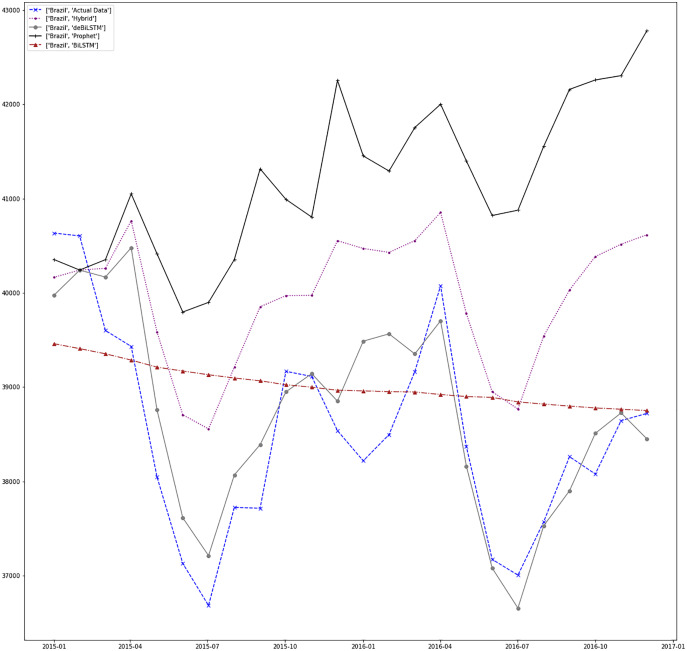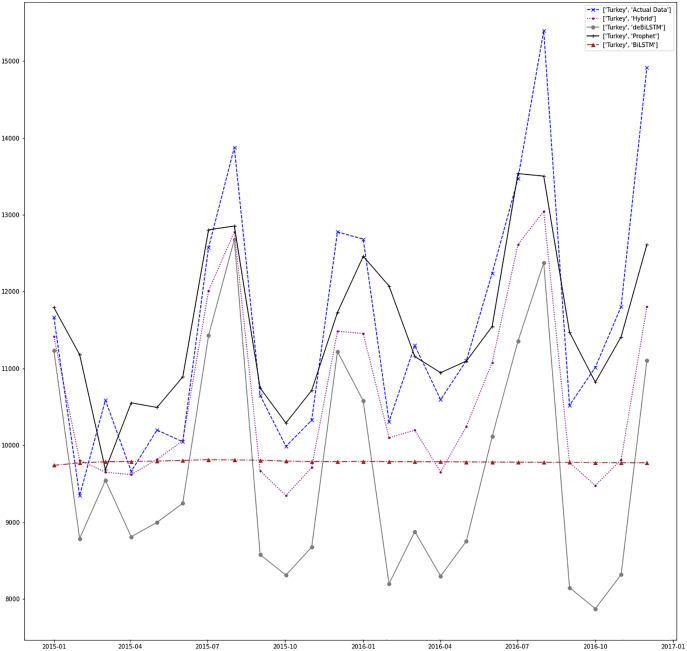Abstract
For decades, time series forecasting had many applications in various industries such as weather, financial, healthcare, business, retail, and energy consumption forecasting. An accurate prediction in these applications is a very important and also difficult task because of high sampling rates leading to monthly, daily, or even hourly data. This high-frequency property of time series data results in complexity and seasonality. Moreover, the time series data can have irregular fluctuations caused by various factors. Thus, using a single model does not result in good accuracy results. In this study, we propose an efficient forecasting framework by hybridizing the recurrent neural network model with Facebook’s Prophet to improve the forecasting performance. Seasonal-trend decomposition based on the Loess (STL) algorithm is applied to the original time series and these decomposed components are used to train our recurrent neural network for reducing the impact of these irregular patterns on final predictions. Moreover, to preserve seasonality, the original time series data is modeled with Prophet, and the output of both sub-models are merged as final prediction values. In experiments, we compared our model with state-of-art methods for real-world energy consumption data of seven countries and the proposed hybrid method demonstrates competitive results to these state-of-art methods.
Keywords: Time series forecasting, LSTM, Prophet, Hybrid model, Seasonality
Introduction
Time series forecasting is a popular research area and has various numbers of application fields such as energy, business, economy, health, and environment. Time series forecasting is a process using a dependent variable’s past values to predict its future values. In detail, time series forecasting models try to understand the classical patterns found in these series. These patterns may include seasonality, trend, and noise. The energy field is one of the most studied areas for time series forecasting. As the population of the world grows, energy consumption and demand are always increasing. Moreover, the supply must meet the demand for energy since it cannot be stored. Therefore, the prediction of this consumption and demand has been regarded as a crucial and complex task (Deb et al., 2017).
There are many studies on forecasting energy consumption using various statistical methods or neural networks. Most of these studies are related to specific countries (Mir et al., 2020; Sen, Tunç & Günay, 2021). El-Hendawi & Wang (2020) used full wavelet packet transform and artificial neural networks for short-term electrical load forecasting for the Ontario region of Canada. Similarly, Kaytez (2020) used the least-square vector machine and other statistical methods for annual net electricity consumption in Turkey. For the annual electricity demand prediction of Turkey, the particle swarm optimization algorithm is used in Gulcu & Kodaz (2017). In Di Leo et al. (2020), linear and nonlinear regression methods are used for energy demand forecasting in Italy. Another regression-based model is used in Angelopoulos, Siskos & Psarras (2019) for forecasting annual electricity demand in Greece. Statistical and regression-based methods are combined in Al-Musaylh et al. (2018) for short-term electricity demand forecasting of Australia. In the study proposed in Liu, Moreno & García (2016), annual primary energy consumption is predicted using a combined fore-casting model.
At present, many single statistical methods are also used to forecast energy demand and consumption (De Felice, Alessandri & Catalano, 2015; Jiang, Yang & Li, 2018; Prajapati et al., 2019; Yuan, Liu & Fang, 2016). The auto-regressive integrated moving average (ARIMA) technique which is one of them (Box et al., 1976), however, does not support time series with a seasonal component. Thus, an extension of ARIMA called seasonal ARIMA (SARIMA) has been proposed. In Hyndman & Khandakar (2008), seasonal ARIMA is used with Holt-Winters model. Regression analysis methods are also widely used in other domains (Hong et al., 2020).
Prophet is an open-source time-series forecasting methodology developed by Facebook. Prophet can be seen as a relatively new approach and has become popular among time-series forecasting methodologies because it has ease of usability and power. Moreover, Prophet has been used in several areas already and results show that it outperforms classical statistical and machine learning approaches, especially in the environment field (Vartholomaios et al., 2021; Zhoul, Chenl & Ni, 2020) because of the characteristics of data in these domains. Prophet is designed to handle forecasting on data which has a multiseasonality feature. Thus, Prophet is a good alternative for forecasting seasonal time series data.
Neural networks are also used widely for energy forecasting and these studies can be found in literature surveys (Angelopoulos, Siskos & Psarras, 2019; Hong et al., 2020; Liu et al., 2020; Verwiebe et al., 2021; Wang et al., 2019). Artificial neural networks are used for quarterly energy demand forecasting of Australia, France, the USA (Bannor & Acheampong, 2020), and Greece (Ekonomou, 2010); grey neural networks are modeled for Spain (Liu et al., 2020). The authors in Nam, Hwangbo & Yoo (2020) used recurrent neural net-works (LSTM and GRU) in order to predict electricity demand and generation of South Korea.
Many studies show that seasonal decomposition or adjustment entails better performance results for energy forecasting (Bandara, Bergmeir & Hewamalage, 2021; Heckman, Pinto & Savelyev, 1999; Zhang & Qi, 2005). With seasonal decomposition, the complexity of the original time series is minimized and this reduces the training and learning time of the neural network model (Yan, 2012). Thus, by removing seasonality, neural networks can learn better the other patterns in time series and some studies show that this improves the prediction accuracy (Andrawis, Atiya & El-Shishiny, 2011; Ben Taieb et al., 2012). The study proposed in Zhang & Li (2021) applies the decomposition method for China’s monthly energy consumption data set and SARIMA, SVR, ANN, and LSTM are used to forecast trends, season, and residual components, respectively. They also applied some modifications of residual component for performance improvement. After applying a modification of the residual component, they combined each model output for the final forecast. However, they deal with time series data by dividing them into components and using each component as input for separate models. Another decomposition-based model is presented in Bedi & Toshniwal (2018). They integrated empirical mode decomposition with deep learning methods for forecasting the energy electricity demand of India. They decomposed the original time series into a set of intrinsic mode functions (IMFs) along with a residue. Each IMFs used as input for the regression model and outputs are combined into the final output. Thus, they divided the original time series into several components and these components are used as input for models and treated as independent of each other. Divina et al. (2019) used SVR with differential EMDs for electric load forecasting in Spain.
Both statistical and neural network based approaches have some drawbacks. The statistical approaches have some limitations because of not effectively handling non-linear part of time series while neural network models suffer from overfitting and also have parameter selection/tuning problem. In order to solve these problems, the hybrid models are used widely for forecasting using the time series. Moreover, the prediction accuracy of a single model is limited and dependent on the data set. Hence, the hybridization of models can result improvement in prediction accuracy. In Soy Temür, Akgün & Temür (2019), the authors try to forecast house sales using ARIMA and neural network approach together. For the linear component of the time series they adapted ARIMA model and for the non-linear component, the LSTM model is used. In a similar way, the study proposed in Dave et al. (2021) uses ARIMA and LSTM for export data of Indonesia. A hybrid model using Prophet and LSTM is proposed in Zhoul, Chenl & Ni (2020) for air quality index. In Rodríguez-Rodríguez et al. (2018), an infrastructure-Artificial Intelligence (AI) model with Prophet is proposed to study of a variety of human energy use. In Ji et al. (2019), hybrid forecasting model using ARIMA and deep neural network is proposed for prediction of carbon prices. They used CNN and LSTM for deep neural network model and showed that hybrid model improves the prediction accuracy. In Kamal et al. (2020), the authors proposed three RNN models, Deep RNN, LSTM and GRU, in order to predict the Baltic dry index. These studies show that the results of ensemble models outperform all of the single models but all of them used time series data without extracting the seasonal patterns.
The energy demand/consumption data can have irregular fluctuation caused by various factors. The decomposition of these data can help us reduce the influence of these factors and also can improve the accuracy of demand/consumption prediction by reflecting real world scenarios. Moreover, after decomposition, each component can be modelled independently, so that the model complexity is less than forecasting the original time series as a whole. While statistical methods use different approaches to deal with all components of time series, including seasonality, there is no general approach or methodology to handle seasonality in neural network models. Because these models are nonlinear they should cope with seasonality directly without transforming the time series. However, for artificial neural networks, removal of seasonal properties are recommended to improve forecasting accuracy (Martínez et al., 2018). In this study, we have developed a hybrid forecasting model to eliminate the influence of these factors by using decomposition method. Our model consists of two sub models; Prophet and stacked bidirectional LSTM. In order to preserve seasonality, our study has used Prophet model for original data. On the other hand, bidirectional stacked LSTM is developed for decomposed time series data to reduce the impact of irregular pat-terns. Final predictions are evaluated by combining outcomes of both models. Another contribution of this study is that hybridization of LSTM with Prophet eliminates the shortcomings of each model. The model is tested by using real world energy consumption data for seven (7) different countries and results show that the proposed model outperforms statistical approaches and also, neural network models for prediction. Moreover, the proposed model is compared with state-of-art-techniques and demonstrated satisfactory forecasting results.
This article is organized as follows. In “Forecasting Methods”, forecasting methods are introduced. The proposed hybrid model is discussed in “Proposed Hybrid Model”. “Results” presents experiment results and discussion in which the performance of our model is evaluated. Finally, “Conclusion” draws some conclusions.
Forecasting Methods
Prophet
Prophet is an open-source time-series forecasting library developed by Facebook. It uses several distinct methods for time series forecasting. It also sup-ports seasonality and holiday week day split. Prophet consists of three main components. The first component is called trend, and is used to describe the trend in the time series data. The second component is seasonality and the third component is holidays. These three components can be described using the following equation:
where, represents trend, represents seasonality and represents holidays. Again, is error term which takes in consideration any irregular changes that may not be accommodated by the model.
LSTM
LSTMs are a special form of a recurrent neural network (RNN) and because of their memory structure, it is widely used in speech recognition, emotional analysis, text analysis, and time series forecasting. In LSTM model, the long sequence of data is remembered or stored by incorporating a gating mechanism. This gating mechanism uses some information from previous steps to produce output by evaluating a function. This output is used to modify the current LSTM cell state. There are three gate structures in LSTM cell; input gates, output gates, and forget gates, and the structure of an LSTM cell is shown in Fig. 1.
Figure 1. LSTM cell structure.
The forget gate is used to determine which information will be kept or not by using the following formula:
where is input at time t, is the output of previous cell, and is sigmoid function. If the output of the forget gate is 1 (one), the information is kept in the cell state. After this step, sigmoid function creates a vector containing possible new values. Input gates decide which values will be updated and new candidate values vector is created by following equation:
Now cell’s old state is updated to new cell state .
Finally, we decide the output of the network and this output is based on our cell state. First, sigmoid layer is used to decide what parts of the cell state will be used and then, tanh function is used for cell state and multiplied by this sigmoid layer:
Stacked LSTMs (SLSTMs) are presented in Graves, Mohamed & Hinton (2013) and use more than one LSTM layers. The first LSTM layer uses time series data as input and produces the output. This output is used to fed next LSTM layer. All LSTM layers have the same internal architecture with different number of units. An example of Stacked LSTM is shown in Fig. 2.
Figure 2. Stacked LSTM network.
Traditional LSTMs uses only previous information in order to determine the next states. Bidirectional LSTMs (BDLSTMs) are developed to process information in both directions (Schuster & Paliwal, 1997). BDLSTMs are constructed by two separate hidden layers so that two independent LSTMs are used together to make bidirectional information passing possible at every time step. There are two different inputs of BDLSTM cell; input from previous steps and input from next step. By using two BDLSTM cell and combining their inputs-outputs, BDLSTM network can store information from both past and future.
Proposed Hybrid Model
Time series data have linear and non-linear relationships. While statistical methods are efficient at handling linear relationships in the time series, they cannot handle non-linear relationships (Martínez et al., 2018). On the other hand, neural network approaches can model linear and non-linear relationships but they depend on appropriate parameter selection and requires a long training time. However, the advantage of neural network(NN) models is that they can effectively handle non-linear relationships.
A hybrid model is implemented to cope with these weaknesses and work together for better performance. The proposed model tries to maintain the seasonality feature and also reduce the impact of this feature at the same time. In order to preserve seasonality, Prophet is adapted along with trend and noise. The Prophet model is mainly composed of three components: trend, seasonality, and holidays. In addition to this, the Prophet model has linear and non-linear growth trend functions to handle different types of time series. Hence, this helps the model fit data sets having different periodic change rules effectively.
On the other hand, we have used stacked bidirectional LSTM model which exploits the decomposition of time series data by removing the repeating temporal patterns. This decomposition and removal of the seasonality feature of time series data cause the system to handle irregular patterns in these data. For the decomposition, seasonal-trend decomposition based on the Loess (STL) method is applied to original time series data. The overall architecture of the proposed model is shown in Fig. 3.
Figure 3. Proposed hybrid model.
First of all, original data is used to feed Prophet model. In order to use this model, the input data is first processed and modified since Prophet model expects only a formatted date and time series variable. After this preprocessing stage, some trend and seasonality parameters of the model are tuned to get fine results. The output of this model is simply forecasting values for the given specific time window.
On the other hand, in order to use the same time series data as input for LSTM, seasonality information is extracted and removed from the original data. Time series data can exhibit a variety of patterns, and it is often helpful to split a time series into several components, each representing an underlying pattern category. An example of decomposition is demonstrated in Fig. 4. The figure shows the original signal and its components. The trend component refers to the general direction in which the time series is moving. Time series can have a positive or a negative trend, but can also have no trend. The seasonality component refers the repeating short-term cycle in the series. The residual or remainder component is what’s left of the time series data after removing its trend and seasonal components.
Figure 4. Decomposition of time series.
The decomposition algorithm simply extracts these three patterns from original data. The combination of the components in time series can be of two types; additive or multiplicative. In the additive time series, the components of the time series are added together to make the original time series. On the other hand, in the multiplicative time series, the components of the time series are multiplicative together.
In this study, in order to decompose the time series data, we have used seasonal decompose method of statsmodels Python library for additive decomposition shown in the following equation;
where, represents trend, represents seasonality and represents residual. As a result, the original time series can be constructed by adding these patterns.
After decomposition process, LSTM model is fitted to trend and residual components to train. Since this model ignores seasonal pattern, the reseasonalization process is applied after the prediction phase. In this process, the relevant seasonal components which are already extracted in decomposition stage are added to the forecasts generated by LSTM model. This is evaluated by a simple add function. The overall training phase is demonstrated in Fig. 5. In the last step, forecasts obtained from each model are aggregated using the combination of the equal weights in order to produce final forecasts.
Figure 5. Steps for training LSTM.
Model evaluation
The performance of a model can be tested by evaluating a comparison between the actual values and the predicted values. In this study, three performance metrics, namely the mean squared error (MSE), root mean square error (RMSE), mean absolute error (MAE) are used to evaluate the performance of each model. These metrics are calculated using the following equations;
where is predicted value and is actual value.
Results
Within the scope of this study, the data set from the study de Oliveira & Cyrino Oliveira (2018) is used. This data set contains monthly data of total electric energy consumption (GWh) in seven different countries, namely Canada, France, Italy, Japan, Brazil, Mexico, and Turkey between 2006–2017 (126 months), and sample data is shown in Table 1. Figure 6 shows the STL decomposition results of the monthly electricity consumption in Brazil. The trend component of the electricity consumption of Brazil is increasing year by year. The time series data of other countries have similar trend and seasonality components.
Table 1. Sample data from energy consumption dataset of seven countries (GWh).
| Date (mm/dd/yy) | Brazil | Canada | France | Italy | Japan | Mexico | Turkey |
|---|---|---|---|---|---|---|---|
| 07/01/06 | 29,114 | 46,205 | 35,518 | 31,877 | 92,375 | 20,964 | 14,792 |
| 08/01/06 | 29,886 | 45,308 | 31,887 | 25,414 | 100,074 | 20,875 | 15,583 |
| 09/01/06 | 29,917 | 42,417 | 34,300 | 28,872 | 84,229 | 19,460 | 13,747 |
| 10/01/06 | 30,144 | 46,657 | 36,782 | 29,335 | 85,673 | 19,539 | 13,148 |
| 11/01/06 | 30,531 | 48,777 | 41,886 | 29,326 | 86,296 | 17,931 | 15,385 |
| 12/01/06 | 30,494 | 53,009 | 49,453 | 29,114 | 91,021 | 17,971 | 15,232 |
Figure 6. Decomposition of Brazilian data.
In order to show performance developments of our study, we compared our proposed hybrid system (Hybrid) with single stacked bidirectional LSTM model (BiLSTM) and also with deseasonalized LSTM model (deBiLSTM). Moreover, a Prophet model (Prophet) was used and compared with our hybrid model. In the training phase of the neural network part of the hybrid model, and also both BiLSTM and deBiLSTM models, the Adam optimizer was used. Mean squared error (MSE) was used as a loss function. We performed a series of tests for parameter selection since there is no global method to estimate these parameters. The selection of model parameters as completely data-dependent. Thus the parameters of the test with the best accuracy result are used throughout the experiments. Table 2 shows the topology for these models. Each model consisted of one input layer and three hidden layers for all countries. The Dropout layers were added to a model between these layers with 0.2 dropout rate. Dropout as used to reduce overfitting and improve the performance of the model Srivastava et al. (2014). At the end of the model, one dense layer as added in order to produce one-dimensional output, and batch size was set to 16 while the epoch parameter was set to 1,000 for training each model.
Table 2. Respective LSTM model topologies for each dataset.
| Dataset | Method | Input | Hidden layer 1 | Hidden layer 2 | Hidden layer 3 | Output | Sample length |
|---|---|---|---|---|---|---|---|
| Canada | Hybrid | (126,1) | 16 | 8 | 4 | (1) | 14 |
| BiLSTM | (126,1) | 16 | 8 | 4 | (1) | 14 | |
| deBiLSTM | (126,1) | 16 | 8 | 4 | (1) | 14 | |
| France | Hybrid | (126,1) | 16 | 8 | 4 | (1) | 14 |
| BiLSTM | (126,1) | 16 | 8 | 4 | (1) | 14 | |
| deBiLSTM | (126,1) | 16 | 8 | 4 | (1) | 14 | |
| Japan | Hybrid | (126,1) | 32 | 16 | 8 | (1) | 5 |
| BiLSTM | (126,1) | 32 | 16 | 8 | (1) | 5 | |
| deBiLSTM | (126,1) | 32 | 16 | 8 | (1) | 5 | |
| Mexico | Hybrid | (126,1) | 64 | 32 | 16 | (1) | 24 |
| BiLSTM | (126,1) | 64 | 32 | 16 | (1) | 24 | |
| deBiLSTM | (126,1) | 64 | 32 | 16 | (1) | 24 | |
| Brazil | Hybrid | (126,1) | 8 | 8 | 4 | (1) | 5 |
| BiLSTM | (126,1) | 8 | 8 | 4 | (1) | 5 | |
| deBiLSTM | (126,1) | 8 | 8 | 4 | (1) | 5 | |
| Turkey | Hybrid | (126,1) | 16 | 8 | 4 | (1) | 14 |
| BiLSTM | (126,1) | 16 | 8 | 4 | (1) | 14 | |
| deBiLSTM | (126,1) | 16 | 8 | 4 | (1) | 14 | |
| Italy | Hybrid | (126,1) | 32 | 16 | 8 | (1) | 5 |
| BiLSTM | (126,1) | 32 | 16 | 8 | (1) | 5 | |
| deBiLSTM | (126,1) | 32 | 16 | 8 | (1) | 5 |
To be able to use time series data with these LSTM models, we should transform these data into a structure of samples with input and output components. The Keras deep learning library provides the TimeseriesGenerator to automatically transform time series data into samples. TimeseriesGenerator uses the length parameter in order to define the sample length used to train the model. This parameter as used for predicting the next value after sample input which has (length) number of elements. For both models, different sample lengths which give the best accuracy results were used and these values are shown in the ‘Sample Length’ column of Table 2. Table 3 shows the performance results of models for each country.
Table 3. Performance results of models for each country.
| Dataset | Method | MAE | MSE | RMSE |
|---|---|---|---|---|
| Canada | Hybrid | 1,778.090 | 5,514,174.558 | 2,348.227 |
| Prophet | 2,692.760 | 16,970,198.845 | 4,119.490 | |
| BiLSTM | 2,024.409 | 7,131,390.874 | 2,670.466 | |
| deBiLSTM | 4,939.208 | 33,110,916.113 | 5,754.208 | |
| France | Hybrid | 1,536.671 | 4,611,178.316 | 2,147.365 |
| Prophet | 3,012.561 | 15,460,298.534 | 3,931.958 | |
| BiLSTM | 1,715.494 | 4,736,708.254 | 2,176.398 | |
| deBiLSTM | 6,313.654 | 47,940,856.736 | 6,923.933 | |
| Japan | Hybrid | 2,802.822 | 11,420,135.400 | 3,379.369 |
| Prophet | 4,921.811 | 31,072,199.315 | 5,574.244 | |
| BiLSTM | 7,470.529 | 84,741,633.077 | 9,205.521 | |
| deBiLSTM | 5,862.992 | 47,186,452.464 | 6,869.239 | |
| Mexico | Hybrid | 8,80.816 | 1,105,985.936 | 1,051.658 |
| Prophet | 1,029.039 | 1,589,788.345 | 1,260.868 | |
| BiLSTM | 881.306 | 1,224,851.574 | 1,106.730 | |
| deBiLSTM | 2,186.271 | 6,005,540.182 | 2,450.620 | |
| Brazil | Hybrid | 1,519.002 | 2,642,345.014 | 1,625.529 |
| Prophet | 2,733.089 | 8,786,595.659 | 2,964.219 | |
| BiLSTM | 903.928 | 1,200,980.218 | 1,095.892 | |
| deBiLSTM | 803.921 | 1,000,117.467 | 1,000.058 | |
| Turkey | Hybrid | 1,122.314 | 1,844,760.862 | 1,358.219 |
| Prophet | 706.916 | 916,967.034 | 957.583 | |
| BiLSTM | 1,792.026 | 5,655,776.258 | 2,378.187 | |
| deBiLSTM | 2,177.616 | 7,583,899.725 | 2,753.888 | |
| Italy | Hybrid | 845.159 | 1,225,318.038 | 1,106.940 |
| Prophet | 1,520.558 | 3,612,153.530 | 1,900.566 | |
| BiLSTM | 1,965.405 | 4,830,733.821 | 2,197.893 | |
| deBiLSTM | 989.882 | 2,667,179.095 | 1,633.150 |
Note: Bold text indicates best results.
Figures 7–13 demonstrate the forecasts generated by each model and also actual data. From the figures and results, we can conclude that using the proposed hybrid model with a deseasonalization approach can substantially improve the forecast accuracy for most of the data sets. The only exceptions are for Turkey, using only Prophet model has better performance results, while for Brazil, the best forecast values are achieved using neural networks only. For the other five countries, the proposed hybrid model performed better.
Figure 7. Prediction results for Canada.
Figure 13. Prediction results for Italy.
Figure 8. Prediction results for France.
Figure 9. Prediction results for Japan.
Figure 10. Prediction results for Mexico.
Figure 11. Prediction results for Brazil.
Figure 12. Prediction results for Turkey.
We also compared the hybrid model with the state-of-art techniques. ARIMA is a state-of-art statistical technique that is widely used in time series domain. Support vector regression (SVR) uses the basic idea of support vector machines for regression problems and it is widely used for learning from training data in order to generate decision boundaries in non-linear space (Smola & Schölkopf, 2004). The Holt-Winters additive model (Winters, 1976) is the most commonly used method since it is simple, effective, and has computing efficiency. It tries to capture seasonality patterns from time series data.
Empirical Mode Decomposition (EMD) is a signal processing method used for the decomposition of signals (Huang et al., 1998). It is a very efficient technique for dealing with non-linear data (Lahmiri, 2015). Recently, EMD is adapted to RNNs for fore-casting of time series. In Bedi & Toshniwal (2018), EMD-LSTM is applied to energy consumption data. EMD-GRU is adapted in Gao et al. (2019) for short-term electricity load forecasting. Table 4 shows this comparison results in terms of RMSE metric. Our method performs better than other methods for Canada, Brazil, and Japan. Despite standard ARIMA and EMD-LSTM models performing better than our model for the other countries, our model results are very close to these results.
Table 4. Comparison with other models.
| Dataset | Method | RMSE |
|---|---|---|
| Canada | Hybrid | 2,348.227 |
| ARIMA | 2,718.240 | |
| SVR | 4,977.226 | |
| Holt-Winters | 2,474.736 | |
| EMD-LSTM | 2,514.770 | |
| EMD-GRU | 2,912.871 | |
| France | Hybrid | 2,147.365 |
| ARIMA | 2,865.827 | |
| SVR | 3,881.359 | |
| Holt-Winters | 2,463.391 | |
| EMD-LSTM | 2,571.966 | |
| EMD-GRU | 2,748.025 | |
| Japan | Hybrid | 3,179.369 |
| ARIMA | 3,267.591 | |
| SVR | 6,883.180 | |
| Holt-Winters | 3,345.802 | |
| EMD-LSTM | 3,401.124 | |
| EMD-GRU | 3,299.705 | |
| Mexico | Hybrid | 1,051.658 |
| ARIMA | 968.572 | |
| SVR | 4,538.936 | |
| Holt-Winters | 1,558.574 | |
| EMD-LSTM | 801.477 | |
| EMD-GRU | 1,022.981 | |
| Brazil | Hybrid | 1,625.529 |
| ARIMA | 1,943.011 | |
| SVR | 2,160.605 | |
| Holt-Winters | 2,961.887 | |
| EMD-LSTM | 907.844 | |
| EMD-GRU | 1,871.742 | |
| Turkey | Hybrid | 1,358.219 |
| ARIMA | 681.329 | |
| SVR | 1,887.737 | |
| Holt-Winters | 707.484 | |
| EMD-LSTM | 1,501.665 | |
| EMD-GRU | 1,444.853 | |
| Italy | Hybrid | 1,106.940 |
| ARIMA | 1,221.386 | |
| SVR | 1,613.364 | |
| Holt-Winters | 803.252 | |
| EMD-LSTM | 768.841 | |
| EMD-GRU | 998.125 |
Note: Bold text indicates the best results.
Conclusion
In this study, we proposed a hybrid forecasting model for time series data to improve prediction accuracy. Our model is based on two different sub-models; a Prophet model for preserving seasonality information of time series and a neural network model (stacked bidirectional LSTM) for a deseasonalized version of this data. Thus, our model is capable of handling seasonality patterns and at the same time, it tries to reduce the impact of this seasonality in the prediction phase. By decomposition of time series data into its patterns, seasonality patterns can be extracted and removed from the original data and deseasonalized data is used in the training phase of the neural network model to have less training time. The extracted seasonality information is added back to the prediction output of the neural network model and final prediction results are produced by merging prediction results generated by both sub-models.
We have evaluated the proposed model with real-world data set, containing monthly energy consumption values of seven countries for ten and half years. The model is compared with the single Prophet model, single stacked bidirectional LSTM model for original data, and also single stacked bidirectional LSTM model for deseasonalized data. The study showed that the decomposition of time series influences the final prediction accuracy because of the removal of irregular fluctuations. In addition to this, the results indicate that using a hybrid model has better prediction results than single models. Moreover, our model is compared with state-of-art techniques including ARIMA, support vector regression (SVR), Holt-Winters exponential smoothing method, EMD-LSTM, and EMD-GRU for time series data. The accuracy results show that our method outperforms these methods for some countries in our dataset while for other countries, it has competitive performance.
In the future, we will try to use different data sources, with seasonality patterns. In addition, various types of RNNs will be adapted to explore the generalization and optimization of the hybrid mechanism.
Supplemental Information
Funding Statement
The author received no funding for this work.
Additional Information and Declarations
Competing Interests
The author declare that they have no competing interests.
Author Contributions
Serdar Arslan conceived and designed the experiments, performed the experiments, analyzed the data, performed the computation work, prepared figures and/or tables, authored or reviewed drafts of the article, and approved the final draft.
Data Availability
The following information was supplied regarding data availability:
The implementation of model and energy data set are available in the Supplemental File.
References
- Al-Musaylh et al. (2018).Al-Musaylh MS, Deo RC, Adamowski JF, Li Y. Short-term electricity demand forecasting with MARS, SVR and ARIMA models using aggregated demand data in Queensland, Australia. Advanced Engineering Informatics. 2018;35:1–16. doi: 10.1016/j.aei.2017.11.002. [DOI] [Google Scholar]
- Andrawis, Atiya & El-Shishiny (2011).Andrawis RR, Atiya AF, El-Shishiny H. Forecast combinations of computational intelligence and linear models for the NN5 time series forecasting competition. International Journal of Forecasting. 2011;27(3):672–688. doi: 10.1016/j.ijforecast.2010.09.005. [DOI] [Google Scholar]
- Angelopoulos, Siskos & Psarras (2019).Angelopoulos D, Siskos Y, Psarras J. Disaggregating time series on multiple criteria for robust forecasting: the case of long-term electricity demand in Greece. European Journal of Operational Research. 2019;275(1):252–265. doi: 10.1016/j.ejor.2018.11.003. [DOI] [Google Scholar]
- Bandara, Bergmeir & Hewamalage (2021).Bandara K, Bergmeir C, Hewamalage H. LSTM-MSNet: leveraging forecasts on sets of related time series with multiple seasonal patterns. IEEE Transactions on Neural Networks and Learning Systems. 2021;32(4):1586–1599. doi: 10.1109/TNNLS.2020.2985720. [DOI] [PubMed] [Google Scholar]
- Bannor & Acheampong (2020).Bannor BE, Acheampong AO. Deploying artificial neural networks for modeling energy demand: international evidence. International Journal of Energy Sector Management. 2020;14(2):285–315. doi: 10.1108/IJESM-06-2019-0008. [DOI] [Google Scholar]
- Bedi & Toshniwal (2018).Bedi J, Toshniwal D. Empirical mode decomposition based deep learning for electricity demand forecasting. IEEE Access. 2018;6:49144–49156. doi: 10.1109/ACCESS.2018.2867681. [DOI] [Google Scholar]
- Ben Taieb et al. (2012).Ben Taieb S, Bontempi G, Atiya AF, Sorjamaa A. A review and comparison of strategies for multi-step ahead time series forecasting based on the NN5 forecasting competition. Expert Systems with Applications. 2012;39(8):7067–7083. doi: 10.1016/j.eswa.2012.01.039. [DOI] [Google Scholar]
- Box et al. (1976).Box GEP, Jenkins GM, Reinsel GC, Ljung GM. Time series analysis: forecasting and control. Oakland: Wiley; 1976. [Google Scholar]
- Dave et al. (2021).Dave E, Leonardo A, Jeanice M, Hanafiah N. Forecasting Indonesia exports using a hybrid model ARIMA-LSTM. Procedia Computer Science. 2021;179(2020):480–487. doi: 10.1016/j.procs.2021.01.031. [DOI] [Google Scholar]
- De Felice, Alessandri & Catalano (2015).De Felice M, Alessandri A, Catalano F. Seasonal climate forecasts for medium-term electricity demand forecasting. Applied Energy. 2015;137(12):435–444. doi: 10.1016/j.apenergy.2014.10.030. [DOI] [Google Scholar]
- de Oliveira & Cyrino Oliveira (2018).de Oliveira EM, Cyrino Oliveira FL. Forecasting mid-long term electric energy consumption through bagging ARIMA and exponential smoothing methods. Energy. 2018;144(3):776–788. doi: 10.1016/j.energy.2017.12.049. [DOI] [Google Scholar]
- Deb et al. (2017).Deb C, Zhang F, Yang J, Lee SE, Shah KW. A review on time series forecasting techniques for building energy consumption. Renewable and Sustainable Energy Reviews. 2017;74:902–924. doi: 10.1016/j.rser.2017.02.085. [DOI] [Google Scholar]
- Di Leo et al. (2020).Di Leo S, Caramuta P, Curci P, Cosmi C. Regression analysis for energy demand projection: an application to TIMES-Basilicata and TIMES-Italy energy models. Energy. 2020;196(12):117058. doi: 10.1016/j.energy.2020.117058. [DOI] [Google Scholar]
- Divina et al. (2019).Divina F, Torres MG, Vela FA, Noguera JLV. A comparative study of time series forecasting methods for short term electric energy consumption prediction in smart buildings. Energies. 2019;12(10):1934. doi: 10.3390/en12101934. [DOI] [Google Scholar]
- Ekonomou (2010).Ekonomou L. Greek long-term energy consumption prediction using artificial neural networks. Energy. 2010;35(2):512–517. doi: 10.1016/j.energy.2009.10.018. [DOI] [Google Scholar]
- El-Hendawi & Wang (2020).El-Hendawi M, Wang Z. An ensemble method of full wavelet packet transform and neural network for short term electrical load forecasting. Electric Power Systems Research. 2020;182(6):106265. doi: 10.1016/j.epsr.2020.106265. [DOI] [Google Scholar]
- Gao et al. (2019).Gao X, Li X, Zhao B, Ji W, Jing X, He Y. Short-term electricity load forecasting model based on EMD-GRU with feature selection. Energies. 2019;12(6):1–18. doi: 10.3390/en12061140. [DOI] [Google Scholar]
- Graves, Mohamed & Hinton (2013).Graves A, Mohamed A-R, Hinton G. Speech recognition with deep recurrent neural networks. 2013. https://arxiv.org/abs/1303.5778 https://arxiv.org/abs/1303.5778
- Gulcu & Kodaz (2017).Gulcu S, Kodaz H. The estimation of the electricity energy demand using particle swarm optimization algorithm: a case study of Turkey. Procedia Computer Science. 2017;111(7):64–70. doi: 10.1016/j.procs.2017.06.011. [DOI] [Google Scholar]
- Heckman, Pinto & Savelyev (1999).Heckman JJ, Pinto R, Savelyev PA. Time series forecasting using neural networks: should the data be deseasonalized first? Journal of Forecasting. 1999;6(11):951–952. doi: 10.1002/(SICI)1099-131X(199909)18:5<359::AID-FOR746>3.0.CO;2-P. [DOI] [Google Scholar]
- Hong et al. (2020).Hong T, Pinson P, Wang Y, Weron R, Yang D, Zareipour H. Energy forecasting: a review and outlook. IEEE Open Access Journal of Power and Energy. 2020;7(September):376–388. doi: 10.1109/OAJPE.2020.3029979. [DOI] [Google Scholar]
- Huang et al. (1998).Huang NE, Shen Z, Long SR, Wu MC, Snin HH, Zheng Q, Yen NC, Tung CC, Liu HH. The empirical mode decomposition and the Hubert spectrum for nonlinear and non-stationary time series analysis. Proceedings of the Royal Society of London. Series A: Mathematical, Physical and Engineering Sciences. 1998;454(1971):903–995. doi: 10.1098/rspa.1998.0193. [DOI] [Google Scholar]
- Hyndman & Khandakar (2008).Hyndman RJ, Khandakar Y. Automatic time series forecasting: the forecast package for R. Journal of Statistical Software. 2008;27(3):1–22. doi: 10.18637/jss.v027.i03. [DOI] [Google Scholar]
- Ji et al. (2019).Ji L, Zou Y, He K, Zhu B. Carbon futures price forecasting based with ARIMA-CNN-LSTM model. Procedia Computer Science. 2019;162(12):33–38. doi: 10.1016/j.procs.2019.11.254. [DOI] [Google Scholar]
- Jiang, Yang & Li (2018).Jiang F, Yang X, Li S. Comparison of forecasting India’s energy demand using an MGM, ARIMA model, MGM-ARIMA model, and BP neural network model. Sustainability. 2018;10(7):2225. doi: 10.3390/su10072225. [DOI] [Google Scholar]
- Kamal et al. (2020).Kamal IM, Bae H, Sunghyun S, Yun H. DERN: deep ensemble learning model for shortand long-term prediction of baltic dry index. Applied Sciences. 2020;10(4):1504. doi: 10.3390/app10041504. [DOI] [Google Scholar]
- Kaytez (2020).Kaytez F. A hybrid approach based on autoregressive integrated moving average and least-square support vector machine for long-term forecasting of net electricity consumption. Energy. 2020;197(2):117200. doi: 10.1016/j.energy.2020.117200. [DOI] [Google Scholar]
- Lahmiri (2015).Lahmiri S. Short papers decomposition in forecasting day-ahead energy prices. IEEE Systems Journal. 2015;11(3):1–4. doi: 10.1109/JSYST.2015.2487339. [DOI] [Google Scholar]
- Liu, Moreno & García (2016).Liu X, Moreno B, García AS. A grey neural network and input-output combined forecasting model. Primary energy consumption forecasts in Spanish economic sectors. Energy. 2016;115(2):1042–1054. doi: 10.1016/j.energy.2016.09.017. [DOI] [Google Scholar]
- Liu et al. (2020).Liu T, Tan Z, Xu C, Chen H, Li Z. Study on deep reinforcement learning techniques for building energy consumption forecasting. Energy and Buildings. 2020;208(4):109675. doi: 10.1016/j.enbuild.2019.109675. [DOI] [Google Scholar]
- Martínez et al. (2018).Martínez F, Frías MP, Pérez-Godoy MD, Rivera AJ. Dealing with seasonality by narrowing the training set in time series forecasting with kNN. Expert Systems with Applications. 2018;103:38–48. doi: 10.1016/j.eswa.2018.03.005. [DOI] [Google Scholar]
- Mir et al. (2020).Mir AA, Alghassab M, Ullah K, Khan ZA, Lu Y, Imran M. A review of electricity demand forecasting in low and middle income countries: the demand determinants and horizons. Sustainability. 2020;12(15):5931. doi: 10.3390/su12155931. [DOI] [Google Scholar]
- Nam, Hwangbo & Yoo (2020).Nam K, Hwangbo S, Yoo C. A deep learning-based forecasting model for renewable energy scenarios to guide sustainable energy policy: a case study of Korea. Renewable and Sustainable Energy Reviews. 2020;122:109725. doi: 10.1016/j.rser.2020.109725. [DOI] [Google Scholar]
- Prajapati et al. (2019).Prajapati S, Swaraj A, Lalwani R, Narwal A, Verma K, Singh G. Comparison of traditional and hybrid time series models for forecasting COVID-19 cases. 2019. https://arxiv.org/abs/2105.03266 https://arxiv.org/abs/2105.03266
- Rodríguez-Rodríguez et al. (2018).Rodríguez-Rodríguez I, González Vidal A, Ramallo González AP, Zamora Mn. Commissioning of the controlled and automatized testing facility for human behavior and control (casita) Sensors. 2018;18(9):2829. doi: 10.3390/s18092829. [DOI] [PMC free article] [PubMed] [Google Scholar]
- Schuster & Paliwal (1997).Schuster M, Paliwal KK. Bidirectional recurrent neural networks. IEEE Transactions on Signal Processing. 1997;45(11):2673–2681. doi: 10.1109/78.650093. [DOI] [Google Scholar]
- Sen, Tunç & Günay (2021).Sen D, Tunç KM, Günay ME. Forecasting electricity consumption of OECD countries: a global machine learning modeling approach. Utilities Policy. 2021;70(April):101222. doi: 10.1016/j.jup.2021.101222. [DOI] [Google Scholar]
- Smola & Schölkopf (2004).Smola AJ, Schölkopf B. A tutorial on support vector regression. Statistics and Computing. 2004;14(3):199–222. doi: 10.1023/B:STCO.0000035301.49549.88. [DOI] [Google Scholar]
- Soy Temür, Akgün & Temür (2019).Soy Temür A, Akgün M, Temür G. Predicting housing sales in Turkey using ARIMA, LSTM and hybrid models. Journal of Business Economics and Management. 2019;20(5):920–938. doi: 10.3846/jbem.2019.10190. [DOI] [Google Scholar]
- Srivastava et al. (2014).Srivastava N, Hinton G, Krizhevsky A, Sutskever I, Salakhutdinov R. Dropout: a simple way to prevent neural networks from overfitting. Journal of Machine Learning Research. 2014;15(56):1929–1958. [Google Scholar]
- Vartholomaios et al. (2021).Vartholomaios A, Karlos S, Kouloumpris E, Tsoumakas G. Short-term renewable energy forecasting in greece using prophet decomposition and tree-based ensembles. International Conference on Database and Expert Systems Applications; 2021. pp. 1–11. [Google Scholar]
- Verwiebe et al. (2021).Verwiebe PA, Seim S, Burges S, Schulz L, Müller-Kirchenbauer J. Modeling energy demand—a systematic literature review. Energies. 2021;14(23):1–58. doi: 10.3390/en14237859. [DOI] [Google Scholar]
- Wang et al. (2019).Wang H, Lei Z, Zhang X, Zhou B, Peng J. A review of deep learning for renewable energy forecasting. Energy Conversion and Management. 2019;198(July):111799. doi: 10.1016/j.enconman.2019.111799. [DOI] [Google Scholar]
- Winters (1976).Winters PR. Forecasting sales by exponentially weighted moving averages BT - mathematical models in marketing: a collection of abstracts. Berlin, Heidelberg: Springer; 1976. pp. 384–386. [Google Scholar]
- Yan (2012).Yan W. Toward automatic time-series forecasting using neural networks. IEEE Transactions on Neural Networks and Learning Systems. 2012;23(7):1028–1039. doi: 10.1109/TNNLS.2012.2198074. [DOI] [PubMed] [Google Scholar]
- Yuan, Liu & Fang (2016).Yuan C, Liu S, Fang Z. Comparison of China’s primary energy consumption forecasting by using ARIMA (the autoregressive integrated moving average) model and GM(1,1) model. Energy. 2016;100(11):384–390. doi: 10.1016/j.energy.2016.02.001. [DOI] [Google Scholar]
- Zhang & Li (2021).Zhang X, Li R. A novel decomposition and combination technique for forecasting monthly electricity consumption. Frontiers in Energy Research. 2021;9(December):1–11. doi: 10.3389/fenrg.2021.792358. [DOI] [Google Scholar]
- Zhang & Qi (2005).Zhang G, Qi M. Neural network forecasting for seasonal and trend time series. European Journal of Operational Research. 2005;160(2):501–514. doi: 10.1016/j.ejor.2003.08.037. [DOI] [Google Scholar]
- Zhoul, Chenl & Ni (2020).Zhoul L, Chenl M, Ni Q. A hybrid prophet-LSTM model for prediction of air quality index. 2020 IEEE Symposium Series on Computational Intelligence, SSCI 2020; Piscataway: IEEE; 2020. pp. 595–601. [Google Scholar]
Associated Data
This section collects any data citations, data availability statements, or supplementary materials included in this article.
Supplementary Materials
Data Availability Statement
The following information was supplied regarding data availability:
The implementation of model and energy data set are available in the Supplemental File.



